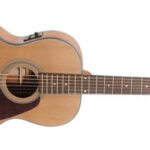Ever felt that irresistible urge to unleash a guitar solo when your favorite song hits? We’ve all been there, air guitar in hand. But transitioning from air guitar hero to playing a real acoustic or electric guitar is a journey that demands practice and commitment.
If you’re serious about learning guitar, you’re likely facing a barrage of questions. What’s the most effective way to learn guitar? Can I master it at home, or do I need a teacher? Should I tackle chords or scales first? It’s easy to feel overwhelmed, and you might even doubt your potential. Many beginners put undue pressure on themselves to become proficient instantly, neglecting the crucial foundational steps.
Take a breath and relax! Learning guitar should be an enjoyable exploration, focusing on the progress you make, not just the end goal. Even seasoned guitarists are constantly discovering new avenues for expression and experimenting with innovative techniques. As a beginner, the optimal approach is to start gradually and immerse yourself in the musical styles that resonate with you. New musicians can quickly discover easy songs to play on guitar, which helps solidify newly acquired skills and chord knowledge through practical application. This hands-on approach is a powerful motivator.
In this guide, we’ll explore essential tips and insights to help you establish a productive practice routine and successfully learn to play guitar. Let’s dive in!
What’s the Most Effective Method for Learning Guitar?
Anything worthwhile requires dedication and effort. Mastering the guitar is no exception. While you might search for the easiest shortcut, the reality is that consistent practice is irreplaceable. Developing a regular practice schedule is paramount.
One of the most crucial lessons for beginner guitarists is patience. Guitar legends weren’t made overnight. Dedicate time each week – even short daily sessions – to practice chords, scales, and fundamental techniques. Cultivating good habits from the start is far more effective than trying to correct bad ones later.
While consistent practice is essential, there are definitely strategies to make learning guitar more accessible and enjoyable.
Top 10 Proven Methods for Learning Guitar
1. Master the Guitar Basics First
The initial steps are always the toughest. Just as you learn to crawl before walking, building a solid foundation in guitar basics is essential for progressing to more complex techniques. Whether you’re learning guitar at home using platforms like Fender Play, or opting for personalized lessons with an instructor, mastering the fundamentals through consistent practice is key to advancing your skills.
While it might not seem as thrilling as playing your first solo, understanding the names of your guitar strings and identifying the parts of your instrument builds essential familiarity. Here are fundamental guitar basics and why they are crucial:
-
Guitar Setup Fundamentals: (How to Set Up a Guitar) Maintaining your guitar in optimal playing condition is crucial for improving your skills and developing your ear. Learn to use a guitar tuner to ensure accurate tuning. Master string replacement in case one breaks during practice. Understanding the different parts of your guitar and their impact on sound is fundamental.
-
String Order and Names: (How to Remember Guitar String Order and Names) Knowing the names and order of guitar strings is essential for identifying notes and tones, and is a prerequisite for more advanced techniques like reading tablature. Discover effective strategies for memorizing string order and names.
-
Holding a Guitar Pick Correctly: (How to Hold A Guitar Pick) Proper pick technique significantly impacts your sound. Understanding how different pick thicknesses influence tone helps you choose the right pick for your desired sound.
-
Playing Individual Notes: (How to Play Notes On Your Guitar) A foundational skill for beginners is learning proper finger placement on the fretboard to produce clear, ringing notes. Clean notes are essential for ear training and learning how to play guitar.
-
Effective Strumming Techniques: (How to Strum like a Pro) Relaxed wrist movement is key to fluid strumming and prevents strain or discomfort after practice. Explore techniques for professional-sounding strumming.
-
Guitar Chords 101: (Guitar Chords 101) Guitar chords are the fundamental building blocks of guitar playing. Even before mastering a guitar solo, beginners can learn simple chords to play along with songs as a rhythm guitarist.
2. Select the Right Guitar for You
Whether you’re drawn to acoustic or electric guitar, or even bass guitar, choosing the right instrument is crucial for your learning journey.
Shopping for your first guitar is an exciting milestone for new players. While aesthetics might be tempting, consider several factors when choosing your guitar.
Utilize tools like Find Your Fender to simplify your search. This tool asks about your preferred tone, budget, and physical attributes like hand size or whether you play guitar left-handed or right-handed. Based on your input, it suggests suitable guitar models to consider.
3. Design an Optimal Learning Space
Creating an environment conducive to practice is a significant first step. If you’re learning guitar at home, a comfortable practice area will encourage more frequent sessions.
Consider these elements when setting up your practice space:
-
Guitar Visibility: Keep your guitar in sight. Visual reminders increase the likelihood of practice. “Out of sight, out of mind” is particularly true with instruments.
-
Optimal Temperature: A comfortable, well-ventilated room is ideal for practice. Extreme temperatures can discourage practice and negatively impact your guitar’s tuning and performance.
-
Adequate Lighting: Ensure your practice space is well-lit, either naturally or artificially. Clear visibility of the fretboard is essential, especially for beginners learning finger placement.
-
Comfortable Seating: A chair or stool promoting good posture is essential. Armless chairs are preferable as they don’t obstruct strumming or fretboard navigation.
-
Privacy and Quiet: Minimize interruptions during practice. Headphones can also be helpful for private practice and preventing disturbance to others.
-
Inspiring Decor: Personalize your space to make it inviting. Decorate with plants, artwork, or posters of favorite musicians to create an inspiring atmosphere that motivates you to practice regularly.
4. Develop Skills Through Song Learning
While mastering notes, scales, and chords is fundamental, applying these skills by learning songs is the most effective way to learn guitar. Practicing chord progressions or techniques like hammer-ons and pull-offs becomes more engaging when applied to real music. It transforms practice from repetitive exercises into a fun, contextualized experience.
Need song suggestions for beginners? Explore Fender’s selection of 40 easy songs to learn on guitar. With a wide variety to choose from, you’re sure to find songs that challenge and inspire you. Further explore Fender Play’s collections to discover popular songs favored by both beginners and experienced players!
5. Train Your Ear to Learn Songs
Consistent practice with notes and chords refines your ear, improving your ability to identify notes and musical patterns. Learning guitar becomes significantly easier when you can discern notes, keys, and chords within songs by ear.
Understanding scales – including sharps, flats, and root notes – helps you identify a song’s key. This knowledge simplifies figuring out the chords and notes used in songs and how artists construct riffs or solos based on scales.
While learning by ear may initially seem challenging, dedicated practice and active music listening will improve your ear training over time. Start by applying this to your rhythm guitar playing, identifying chords in simple tunes. As your skills advance, apply this to learning guitar solos or even creating your own solos.
6. Connect With Fellow Learners
Learning guitar can be more enriching when shared. If you’re learning at home, connecting with other beginners provides valuable support, shared experiences, and mutual encouragement. A community of musicians fosters motivation, practice consistency, and mutual support.
Fender Play understands the power of community. It connects you with musicians at similar learning stages, as well as experienced players who can offer guidance and help you advance your skills.
Fender Play LIVE offers weekly free YouTube episodes for players of all levels. These sessions teach songs, explore techniques across genres, and provide insights from experienced musicians. Additionally, the Fender Play online community allows players to connect, share progress, ask questions, and celebrate achievements.
7. Practice Regularly and Effectively
Consistent practice is the cornerstone of guitar improvement. Here are tips to maximize your practice sessions:
-
Schedule Regular Practice: Even 15 minutes daily can lead to significant progress. Fender Play’s concise video lessons are structured to guide your practice, building skills progressively.
-
Warm-up Before Playing: Finger warm-ups and scale practice prepare your hands and ensure your guitar is in tune.
-
Record Your Progress: Tracking your progress is motivating. Don’t compare yourself to others; focus on your own improvement. Record sessions to compare your playing over time and identify areas for growth. Self-review, like instant replay in sports, helps pinpoint both mistakes and successes.
-
Explore New Techniques: Don’t get stuck in a rut. Learn new scales, chord variations, and apply these to new songs. Expand your repertoire and skill set continuously.
-
Practice with Others or a Metronome: While playing with others might be daunting initially, practicing with a metronome or backing tracks prepares you for band settings. Fender Play’s practice mode includes a metronome and backing tracks to develop timing and simulate playing with others.
8. Be Kind to Yourself and Patient
“Practice makes perfect” is true, but patience is equally important. Every guitarist has good and bad days. Initially, expect some missed notes and unclear chords. That’s perfectly normal! Progress takes time!
Even professional musicians have off days. When learning, don’t let frustration overshadow your progress. Learn from mistakes and persevere. Patience is key. As you notice improvements – fewer errors, smoother chord transitions, increased speed and accuracy – you’ll appreciate your patience and persistence.
9. Utilize Guitar Learning Apps Like Fender Play
Guitar lesson apps offer accessible learning tools for all levels. Fender Play provides access to expert instructors who offer a structured curriculum of bite-sized video lessons. The app’s portability allows you to practice anytime, anywhere, at your own pace. Revisit lessons as needed until you fully grasp concepts. Fender Play also includes a library of hundreds of songs to learn, applying your skills to practical music.
Begin your musical journey today with a free trial of Fender Play!
Conclusion
Learning guitar is a rewarding journey that blends dedication, effective strategies, and a positive mindset. By mastering the fundamentals, creating a supportive learning environment, practicing consistently, and utilizing resources like Fender Play, you can achieve your musical goals. Remember to be patient with yourself, celebrate your progress, and most importantly, enjoy the process of learning How I Learned To Play Guitar!


